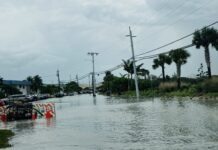It’s done.
The construction of Marathon’s wastewater and stormwater project is largely complete. The sewage treatment plants for areas 1, 3, 4, 5, 6 and Little Venice are finished and roughly 67 percent of property owners are hooked up to the system.
The only thing left to tally is the bill.
The entire project cost $126.5 million and after $26.8 million in grants, the city of Marathon owes $84.5 million in government-issued, low-interest loans. This number is expected to be lowered next year after Tallahassee awards the Monroe County another gran, $20 million of which has been promised to Marathon.
According to City Finance Director Peter Rosasco the system was initially estimated to cost $80 million, but said the final numbers are just about on target.
“A team of us sat down eight years ago to figure out what this was going to cost, where the money was going to come from, the cost of those funds and to figure out the assessments for the residents and businesses,” he said. “It involved careful forethought and, frankly, some estimation.”
He said if taxpayers count the “free” money received and to be received from grants, it IS close to the mark.
Rosasco explained there were two goals at the outset of the planning stages for building the stormwater and wastewater systems in Marathon. First, to make the rate stable; the goal of any public project. Second, to cover 40 percent of the project’s cost with grants, the other 60 percent to be paid for by the City of Marathon and its taxpayers. Right now, that ratio stands at about 20 percent grant money and 80 percent Marathon debt. However, if Marathon is awarded the $20 million Stan Mayfield state grant, the project dollars would stand at a 37 to 73 ratio.
So far, Marathon has received a $16 million grant from the Army Corps of Engineers, an $8 million grant from the state Department of Environmental Protection and a $2.7 million grant from the South Florida Water Management District. Besides pinning their hopes on the Stan Mayfield grant of $20 million, city officials haven’t given up hope that there might be more money coming from the Army Corps of Engineers, something that the city’s lobbyist is tasked with pursuing in Washington, D.C.
Marathon has already paid off approximately $15 million of the construction loan but it still owes approximately $84.5 million. And it’s expected the city will spend another $500,000 on the final details of the sewer project including finishing the Keys RV park hookup. The loans came from the state government’s Department of Environmental Protection’s coffers; funds set apart specifically for this purpose.
“The money is supposed to be loaned out to governments and special districts for water-type projects,” Rosasco said.
Other loan money originated with the federal Environmental Protection Agency and was funneled through the state for distribution. Interest rates on the government loans range from 1.9 to 2.4 percent for the 20-year term.
At various points during construction, the City of Marathon took out commercial-rate “bridge loans” to keep construction going during fiscally lean years in Tallahassee. The last existing private loan is a $30 million loan from Regions Bank that Rosasco said would be paid off with a state-backed loan with a lower interest rate by the end of the year.
So far, Marathon has paid down about $15 million on the $100 million it spent “out of pocket” by collecting assessment fees — or the bill property owners paid the city to connect to the system. According to City Manager Roger Hernstadt, when citizens paid the total sewer assessment up front, that money went toward the debt. Ditto the money collected on the property tax bill for those that chose to finance the assessment over a period of years.
“When those fees were collected, they were spent right away,” Hernstadt said.
The rest of the debt will be paid down over the next 20 years and the mechanism for doing so is built into the city budget. According to the most recent one, the annual budget for the stormwater system is $1,650,000 and the annual budget for the wastewater system is $4,235,000. Those budget figures cover the debt service and the reserves, plus operating costs such as maintenance and capital improvements as the systems age.
“I think a lot of people perceive the initial construction to be the difficult part, and it has its own series of challenges,” said Herndstadt. “But now we migrate to the operation and the maintenance of the system and it will have it’s unique challenges, but more particularly, it’s forever. We have to operate the system effectively and efficiently, while maintaining the level of service and meeting state standards for treatment.”
The only other bit of fiscal relief comes from Marathon’s share of Monroe County’s one-cent sales tax for capital infrastructure. Because stormwater funding is “harder to get,” according to Rosasco, $650,000 is being directed to the annual budget for stormwater’s bottom line.
Regardless, Rosasco said, Marathon got a bargain on its wastewater and stormwater construction.
“I think the recession actually helped us,” he said. “We got some stimulus money [from the Army Corps of Engineers grant] and the contractors were hungry for work. We did both the stormwater and wastewater systems at once and repaved the roads. Improvements to Marathon’s infrastructure not only help with our redevelopment efforts but also protect our nearshore waters.”
Marathon almost completed the project by the state’s 2010 deadline and city officials are confident it will be finished far in advance of the 2015 extended deadline.
Both the stormwater project and wastewater project were mandated by authorities that supersede the city of Marathon’s. The stormwater project was a federally mandated project and the wastewater was a state mandated project.
By the numbers:
• No of wastewater connections required in Marathon: 5,812
• No. of wastewater connections completed: 3,906
• No. of wastewater connections incomplete: 1,906
• Area 1, Knights Key: 55% connected
• Area 3, Old Town: 54% connected
• Area 4, Sombrero: 91% connected
• Area 5, Little Venice expansion: 54% connected
• Area 6, Coco Plum: 99% connected
• Area 7, Grassy Key: 18% connected
Wastewater plants in areas 1, 4, 5, 6, and the Little Venice expansion are complete except for the Key RV collection system in area 4. Area 3 and 7 are complete, but awaiting final record drawings. Area 2 covers the unpopulated Boot Key and, thus, isn’t served.

























